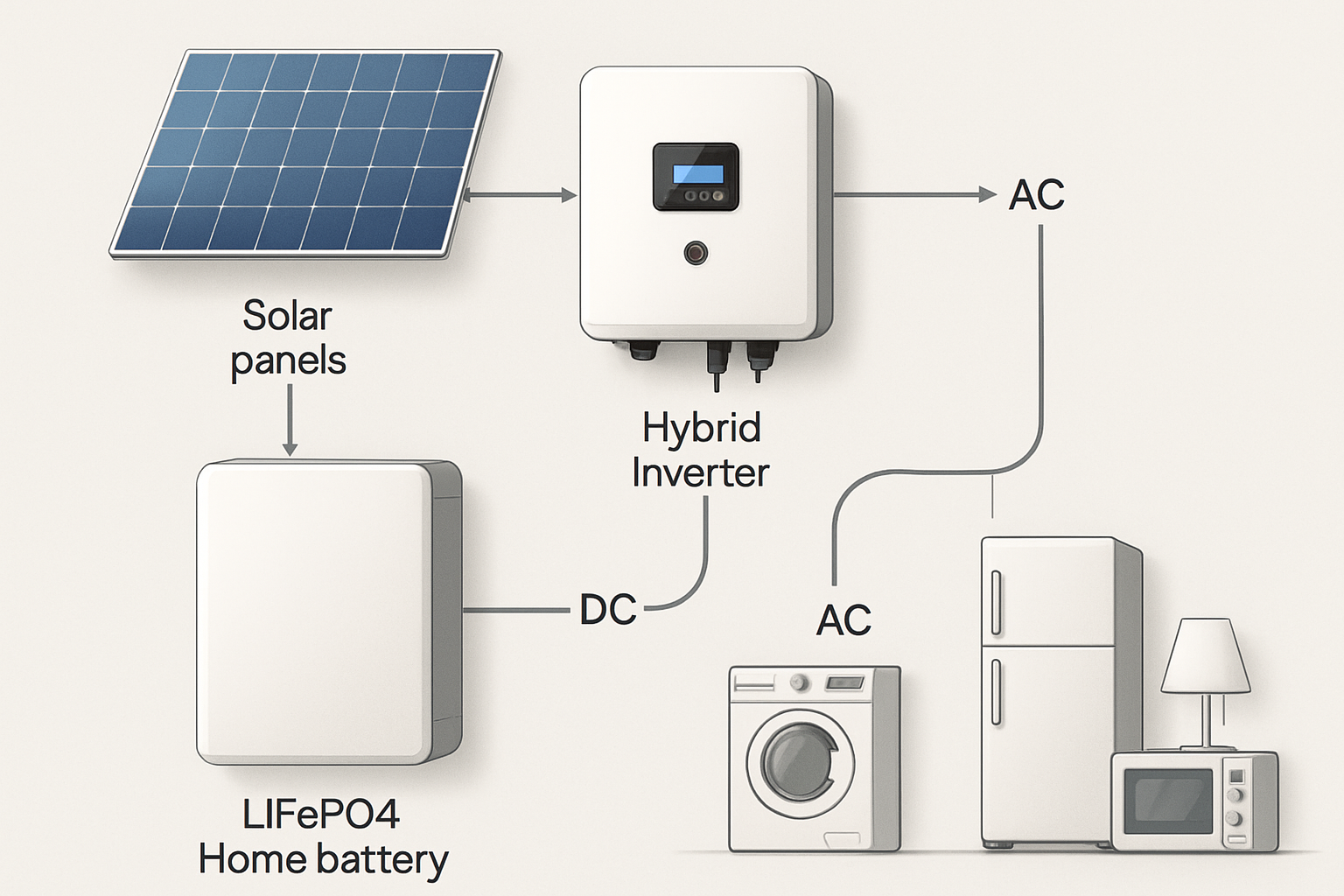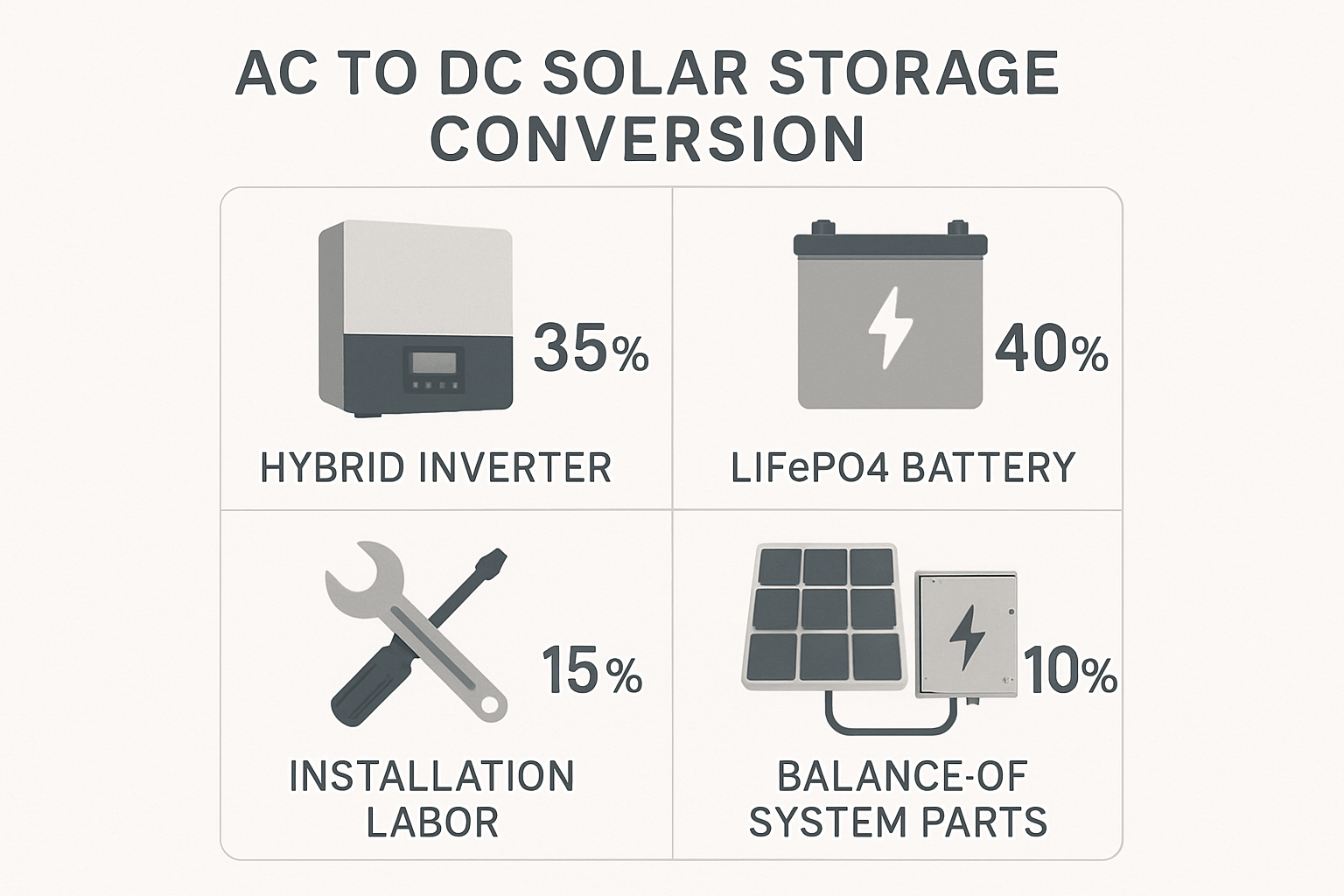The core of a solar energy system's effectiveness lies not just in its panels, but in how it manages and converts electricity. Understanding the flow of power, specifically the AC to DC conversion, is fundamental to designing an efficient solar energy storage solution. This process is surrounded by myths that can create confusion. Clearing up these misconceptions reveals how a well-designed AC to DC storage system is key to achieving energy independence.
The Fundamentals of AC and DC in Solar Systems
At the most basic level, electricity flows in two ways: as Direct Current (DC) or Alternating Current (AC). A solar energy storage system must handle both to power your home and store energy for later use.
What is Direct Current (DC)?
Direct Current is a straightforward, one-way flow of electric charge. Your solar panels generate DC power when sunlight strikes them. Energy is also stored in batteries, such as high-performance lithium iron phosphate (LiFePO4) models, as DC power. This makes the DC side of your system the foundation of energy generation and storage.
What is Alternating Current (AC)?
Alternating Current is the standard form of electricity used by the utility grid and most household appliances. Its direction reverses periodically, allowing it to travel efficiently over long distances. To use the power from your panels or battery, it must be converted into AC.
Why Conversion is Necessary
The bridge between solar generation (DC), battery storage (DC), and home usage (AC) is the solar power inverter. This device is responsible for converting electricity from one form to another. A hybrid inverter, for instance, can manage bidirectional conversion, turning DC from panels into AC for your home, and turning AC from the grid into DC to charge your batteries.
Debunking Common Myths About AC to DC Conversion
Several myths persist regarding the conversion process. Addressing them with facts helps in making informed decisions about your solar energy storage setup.
Myth 1: Conversion is Always Inefficient and Wasteful
Reality: While no conversion is 100% perfect, modern inverters are remarkably efficient. High-quality solar inverters typically boast efficiency ratings between 95% and 98%. This means only a small fraction of energy (2-5%) is lost as heat during the process. According to research from institutions like the U.S. Department of Energy, these minimal losses are a planned and manageable aspect of system design, not a significant flaw.
Myth 2: You Only Need One Type of Conversion (DC to AC)
Reality: A comprehensive solar energy storage system requires bidirectional conversion. The solar power inverter function is multifaceted: it converts DC from panels to AC for immediate use, but it also handles AC to DC conversion to charge the battery from the grid, which is useful for taking advantage of lower off-peak electricity rates. When you need to draw from your battery, it converts the stored DC power back to AC.
Myth 3: All Inverters Perform the Same Conversion Task
Reality: Inverters are specialized. The three main types—string inverters, microinverters, and hybrid inverters—serve different system architectures. A hybrid inverter is the most versatile for a complete AC to DC storage system, managing power flow between panels, batteries, and the grid seamlessly.
| Inverter Type | Primary Function | Best For | Conversion Path |
|---|---|---|---|
| String Inverter | Converts DC from a 'string' of panels to AC | Simple, unshaded roofs | Centralized DC to AC |
| Microinverter | Converts DC to AC at each individual panel | Complex or shaded roofs | Distributed DC to AC |
| Hybrid Inverter | Manages power from panels, batteries, and grid | Solar + Storage systems | Bidirectional: DC <=> AC |
The Role of the Inverter in an AC to DC Storage System
The inverter is the brain of your solar operation, performing tasks far beyond simple conversion. It optimizes power generation, ensures safety, and manages your entire energy ecosystem.
More Than Just a Converter
Modern hybrid inverters integrate multiple technologies. They often include Maximum Power Point Tracking (MPPT) to maximize the energy harvested from panels under various conditions. They also manage the connection to the grid, ensuring stability and safety, and oversee the battery's state of charge to prolong its life.
AC-Coupled vs. DC-Coupled Systems
The system architecture also impacts efficiency. In an AC-coupled system, solar DC power is first converted to AC for the home, and then a separate inverter converts it back to DC to charge a battery. This is great for retrofitting storage to an existing solar installation. A DC-coupled system is generally more efficient for new installations, as the DC power from the panels can directly charge the DC battery with fewer conversion steps, often resulting in efficiencies up to 98%. According to the International Energy Agency (IEA), system design is a critical factor in overall performance. A deeper analysis of system components is crucial for maximizing output. For instance, understanding the performance metrics of different battery chemistries, as detailed in this ultimate reference on solar storage performance, can significantly impact your system's longevity and efficiency.
Practical Implications for Homeowners
Understanding the realities of AC to DC conversion empowers you to build a more effective and reliable home energy system.
Choosing the Right Components
Your choice of an inverter and coupling strategy should align with your goals. For new, all-in-one systems, a DC-coupled configuration with a powerful hybrid inverter and a durable LiFePO4 battery often provides the highest efficiency. For existing systems, AC-coupling is a practical way to add storage.
A Note on Safety and Installation
Proper installation by a qualified professional is paramount for both safety and performance. Ensure all components, especially inverters and batteries, are certified to meet local and national safety standards.
Disclaimer: This content is for informational purposes only and does not constitute professional legal or financial advice.
Looking Ahead: The Future of Power Conversion
The technology behind power conversion is continually advancing. Innovations in wide-bandgap semiconductors are pushing inverter efficiencies even higher, further minimizing energy loss. As organizations like the International Renewable Energy Agency (IRENA) note, these advancements are making solar and storage solutions more affordable and accessible. According to an IRENA report, accelerated deployment of solar PV can lead to a 21% reduction in total energy sector emission mitigation potential by 2050.
Your Path to Energy Independence
Grasping the facts behind AC to DC conversion is a key step toward designing a robust solar energy storage system. The conversion process, managed by a sophisticated inverter, is not a weakness but a core strength of modern solar solutions. By selecting the right components and system design, you can create a reliable, scalable, and efficient system that puts you in control of your energy future.
Frequently Asked Questions
How much energy is lost during AC to DC conversion?
Energy loss during conversion is minimal with modern technology. High-quality inverters have efficiency ratings between 95% and 98%, meaning only 2-5% of the energy is lost as heat during the process.
Can I add a battery to my existing solar panel system?
Yes. This is a common scenario and is typically achieved with an AC-coupled system. A separate battery inverter is added to your setup to convert AC power from your solar inverter back into DC power to charge the battery.
What's the difference between a hybrid inverter and a regular solar inverter?
A regular solar inverter performs a one-way conversion, changing DC power from solar panels into AC power for your home. A hybrid inverter is bidirectional; it can convert DC to AC, convert AC from the grid to DC for battery charging, and manage the power flow between your panels, battery, home, and the grid.





Leave a comment
All comments are moderated before being published.
This site is protected by hCaptcha and the hCaptcha Privacy Policy and Terms of Service apply.